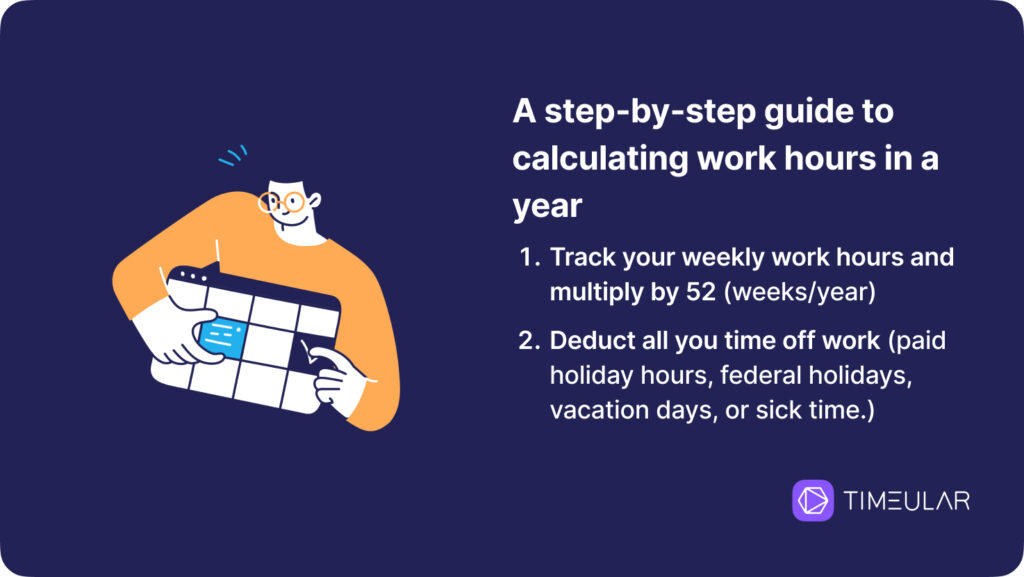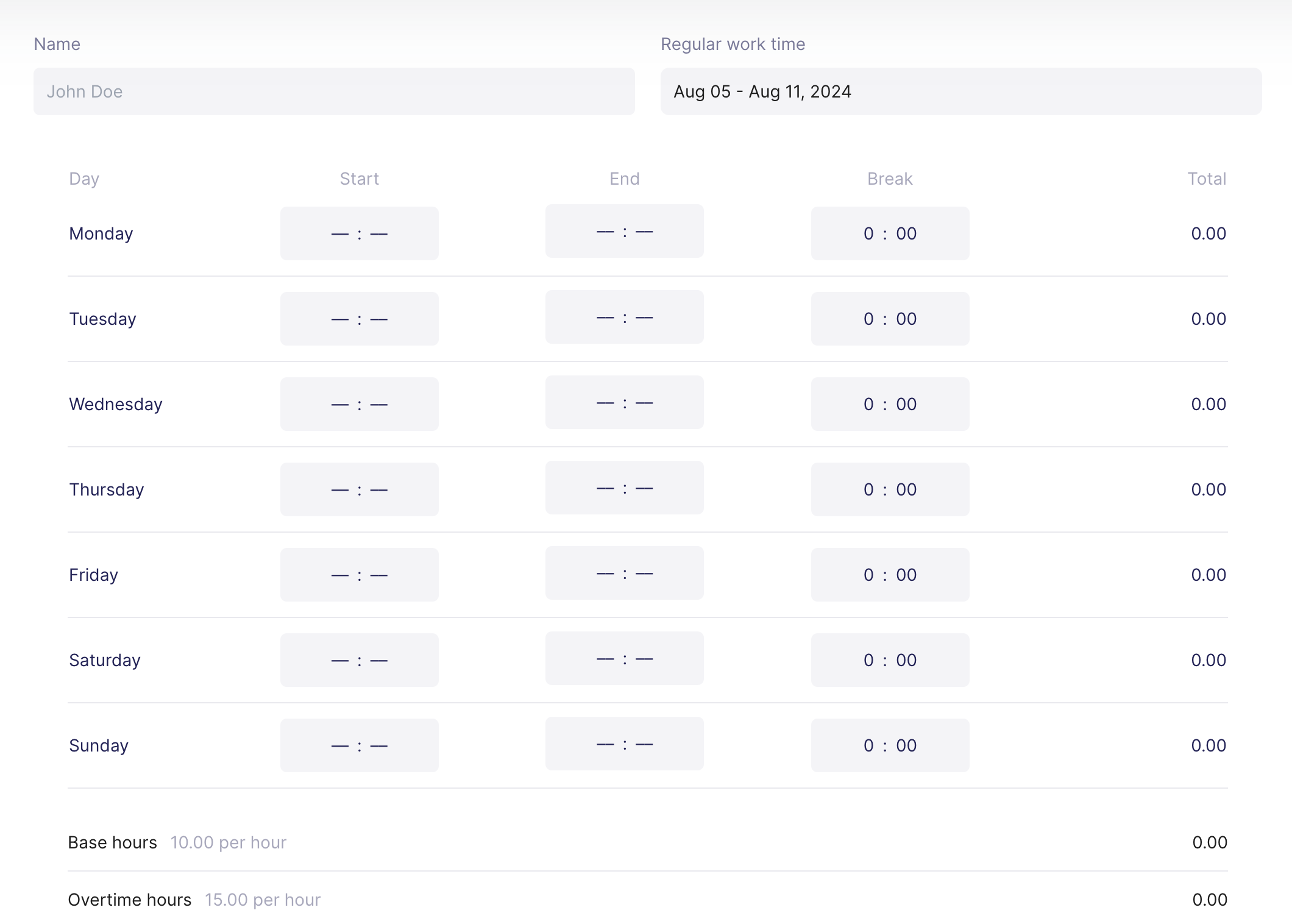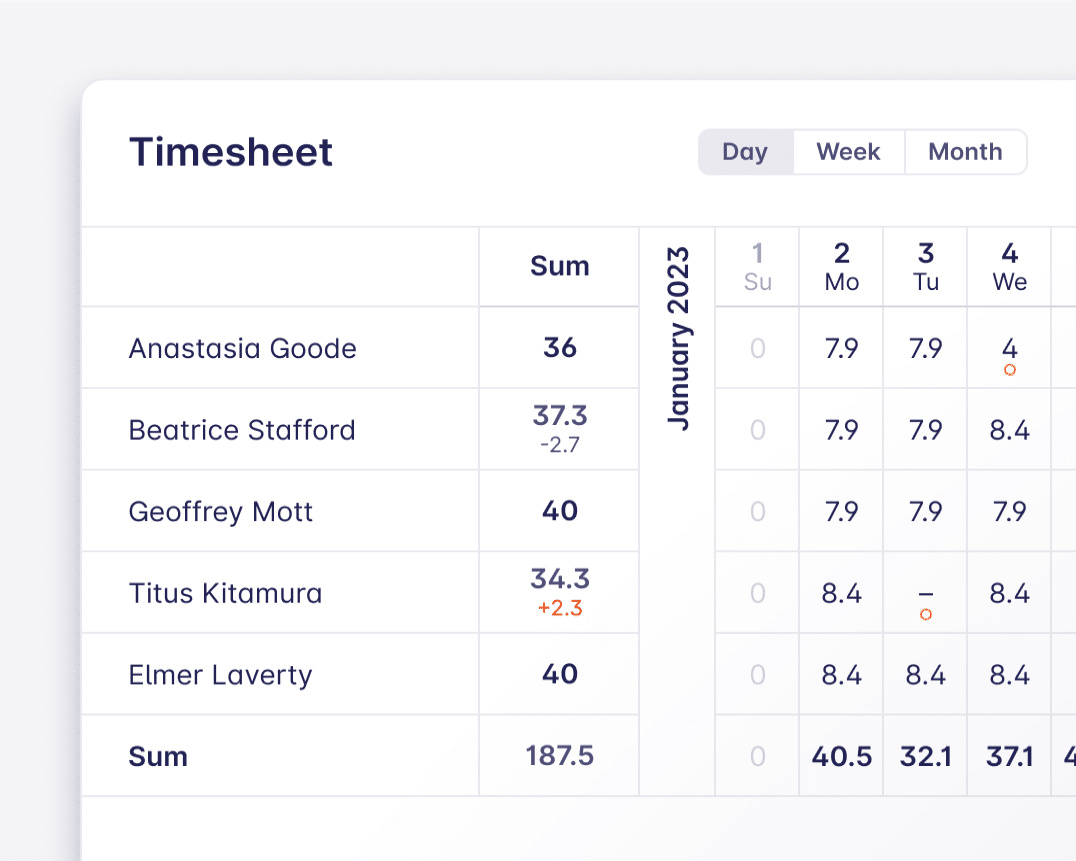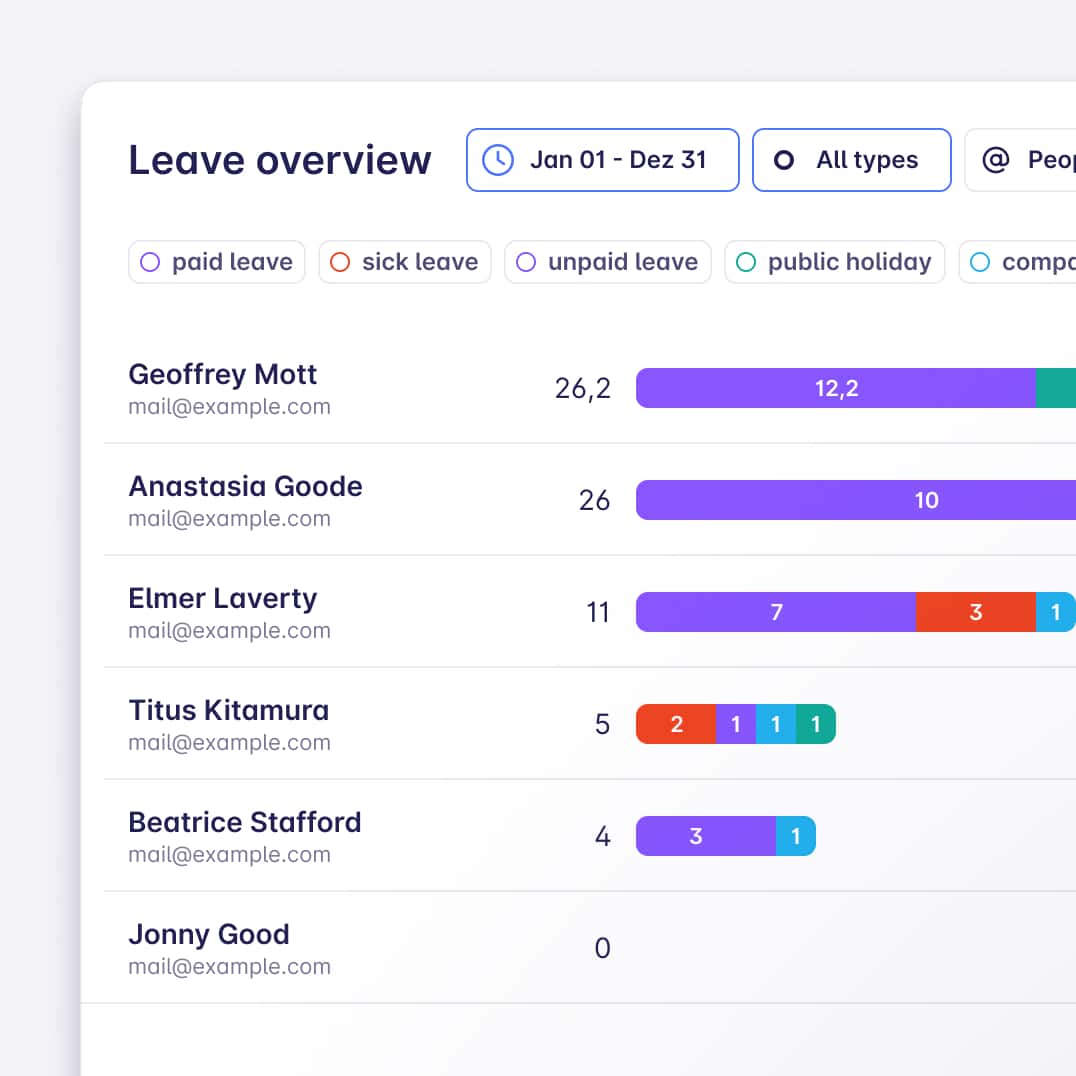How Many Work Hours in a Year? A Comprehensive Guide
Are you curious about how many work hours are in a year? I’ve counted the work days and crunched the numbers so you can have a clear idea of your working hours in a year.
Before we get cracking, here’s what you’ll learn in this article:
A breakdown of the factors that influence the total work hours in a year
Accurate calculations and formulas on how many hours you work in a year
How an automatic work hours tracker helps keep track of every work hour
The standard work hours in a year
To calculate work hours accurately, we need to start from the standard yearly work hours, which apply to most of the United States and not only.
If we start with the standard schedule of typical full-time employees, the average hours worked, and regular paid time off, we’ll be calculating work hours with ease.
A typical full-time job consists of 40 weekly hours of work
There are 52 weeks in a year
Using these figures, I’ll make a simple calculation:
40 hours/week × 52 weeks = 2,080 total hours worked per year
This number, 2,080 hours, is often used as the standard for full-time employment in many countries, including the United States. Remember that at this stage of the calculation, I have not included paid holiday hours, specific holidays for federal employees, or overtime hours.

Make sure your time is well spent by managing it with automatic, smart and secure time tracking apps.
Once I demonstrate how to deduct the above and what factors need to be taken into consideration to obtain the total hours of work, you will discover how many working hours you have in a year.
If you’d like to explore this topic more, I’ve written a guide on how many work days there are in a year, too. I’ve also explained concepts like leap year and why 2024 is a leap year.
Work hours based on a weekly schedule
Even if there’s a standard number of hours worked per week generally accepted, many of us have a flexible hour workweek, so the average working hours differ. Some of us choose to work less to spend more time with our families or simply to achieve a healthy work-life balance.
Regardless of our reasons, we end up with a different work schedule, which determines how many hours we work in a year. Here’s a breakdown of yearly work hours based on different weekly schedules:
20 work hours per week leads to 1,040 hours worked in a year
25 work hours per week leads to 1,300 hours worked in a year
30 work hours per week leads to 1,560 hours worked in a year
35 work hours per week leads to 1,820 hours worked in a year
40 work hours per week leads to 2,080 hours worked in a year
45 work hours per week leads to 2,340 hours worked in a year
50 work hours per week leads to 2,600 hours worked in a year
55 work hours per week leads to 2,860 hours worked in a year
60 work hours per week leads to 3,120 hours worked in a year
How many non-work hours do you have in a year?
In order to find out the number of hours in which you’re not working in a calendar year, you’ll need to subtract the total number of hours worked in a year from the total hours in a year.
A typical year comprises 8,760 hours (365 days × 24 hours = 8,760 hours). Starting from this premises, let’s uncover how many non-work hours you have in a year based on different work schedules:
20-hour workweek: 8,760 hours – 1,040 work hours = 7,720 non-working hours
25-hour workweek: 8,760 hours – 1,300 work hours = 7,460 non-working hours
30-hour workweek: 8,760 hours – 1,560 work hours = 7,200 non-working hours
35-hour workweek: 8,760 hours – 1,820 work hours = 6,940 non-working hours
40-hour workweek: 8,760 hours – 2,080 work hours = 6,680 non-working hours
45-hour workweek: 8,760 hours – 2,340 work hours = 6,420 non-working hours
50-hour workweek: 8,760 hours – 2,600 work hours = 6,160 non-working hours
55-hour workweek: 8,760 hours – 2,860 work hours = 5,900 non-working hours
60-hour workweek: 8,760 hours – 3,120 work hours = 5,640 non-working hours
You know best how you’re planning your non-working hours. However, spending them on leisure activities and non-work-related tasks contributes to your well-being and work-life balance. What’s more, being aware of the number of hours off work helps you plan your PTO hours and holidays.
Factors affecting annual work hours
As demonstrated above, there are a few baselines for the number of work hours someone generally has; however, we still need to account for several factors that significantly impact the actual number of hours an employee works in a year.
The weekly work hours and yearly can depend on company policies, industry standards, or individual circumstances.
These factors are public holidays, federal holidays, sick days, personal time off, or overtime hours/days.
To calculate the total hours worked in a year, you’ll need to perform the following:
Total hours in a work year = (Number of working hours per week x 52) – [(PTO days + number of paid holidays) x number of working hours per day]
Guide to calculate work hours in a year

1. Track your work hours
Both as an employee and an employer, you want to make sure you’re not working too many hours in a year. So, the first step in understanding your own labor statistics is to track your weekly hours of work diligently. This way, you’ll be able to easily calculate your total yearly work hours by multiplying them by 52.
How? Simply multiply your hours worked in a day by the number of working days in a week. If you’re looking for a seamless method, try Timeular’s time card calculator, as it calculates your work hours automatically. Here’s a preview of the calculator:

The calculator will automatically summarize base hours, overtime tracking, total work hours, and total pay based on your input. Your time spent on work will be converted into decimal hours automatically.
You’re able to download the time card data in a PDF format and print it out to keep a hard copy if needed.
Now, to obtain the total number of annual hours in a year, you need to multiply it by 52. For example, if you tracked 41 hours of work during a week, which includes overtime or additional hours, you will multiply it by 52, as follows:
41 hours of work/week x 52 = 2,132 work hours/year
Note that you still need to deduct certain days, like vacation days and other paid time off.
2. Deduct your time off
From the total you obtained so far, in order to get to the final annual hours in a year, you need to deduct paid holiday hours, federal holidays, vacation days, or sick time.
The paid time off depend on the country and its public holidays or the policies of the companies you’re working for.
Most employers offer paid holidays to their salaried employees, though they are not liable by law. In the U.S., the average number of paid holidays is 7-11 days per year. The US federal holidays are listed on the U.S. Office of Personnel Management Website, but here are the federal holidays for the record:
New Year’s Day — Monday, January 1st,
Martin Luther King Jr. Day — Monday, January 15th,
Presidents’ Day (or Washington’s Birthday) — Monday, February 19th,
Memorial Day — Monday, May 27th,
Juneteenth National Independence Day — Wednesday, June 19th,
Independence Day — Thursday, July 4th,
Labor Day — Monday, September 2nd,
Columbus Day — Monday, October 14th,
Veterans Day — Monday, November 11th,
Thanksgiving Day — Thursday, November 28th, and
Christmas Day — Wednesday, December 25th.
After deducting the federal holidays, full-time workers on a standard schedule will need to add up to 88 hours (resulting from 8 hours a day x 11 federal days).
So, the public holidays reduce the number of hours worked to 88 hours in the United States.
Deduct all time off from your yearly hours
The average paid vacation time in the U.S. ranges from 10-20 days, depending on your years of service. So, deduct holiday hours, too, in your final calculation.
Also, consider that you might also need some sick leave or just personal days off in which you need to take care of your personal errands or challenges. Many companies do offer paid sick leave and personal days.
Starting from the premises that you worked for 8 hours a day in a year, and you have 11 public holidays, together with ten more holiday days, you end up with:
2,080 hours – 88 hours (public holidays) – 80 hours (vacation days) = 1,912 total annual work hours

An automatic time-tracking makes you aware of your time-spending habits and helps you make better use of your time.
Why does should you know your annual work hours?
One of the main reasons is that you’re spending 71,5% of your year at work on a standard schedule, which is quite a lot of your time, right? You should leverage it and spend it wisely.
At the same time, understanding your annual work hours is far more than just a numerical exercise. Your relationship with work can have profound implications on your personal time and life, too. Let’s explore both the commonly recognized and the often-overlooked benefits of knowing your yearly work hours.
1. Accurate salary calculations and negotiations
For hourly employees or part-time workers, knowing your annual work hours is crucial for estimating your yearly earnings and obtaining fair pay. This knowledge empowers hourly workers to, and not only to:
Compare job offers and hourly rates, and, if the case, negotiate raises with a clear understanding of your current compensation;
Plan for potential overtime earnings based on your overtime pay;
Make informed decisions on your annual spending, holidays taken, and investments;
Understand the true value of your time, potentially leading to more informed career decisions.
2. Work-life balance optimization
Awareness of your annual work hours comes up with a specific measure of your time allocation, which then allows you to:
Assess whether your current job aligns with your lifestyle goals or not;
Identify periods of overwork and potential burnout risks, which are higher and higher, according to research, particularly after the Pandemic;
Plan your work capacity based on your regular hours of work and time off;
Justify requests for flexible working schedules, additional time off, or working extra hours;
3. Legal compliance and employee rights
Understanding annual work hours is pivotal for both employers and employees when discussing legal considerations:
Ensuring compliance with labor laws regarding overtime, breaks, and maximum working hours a day or shifts;
Identifying potential wage and hour violations;
Supporting cases for fair labor practices or workplace improvements;
Helping with accurate calculation of benefits, holiday pay, and retirement contributions;
4. Precise budgeting and financial planning
Both individuals and businesses benefit from accurate work-hour calculations by:
Creating precise personal budgets or company forecasts;
Planning for major expenses or investments based on expected earnings;
Estimating tax liabilities more accurately;
Making informed decisions about savings and retirement planning;
Timeular fills out timesheets automatically
If you’re either an employee, part of the HR team or the founder of an agency who needs to invoice, or calculate payroll hours, but stumble upon the question “how many work hours did I do” or ” how many work hours did this employee do this month”, an automatic time tracking alleviates your pain.
Yes, sending manual timesheet reminders or sending timesheet memes can work, but it’s consuming your time, and let’s be honest, we’re living in the all-automatic era, and we need to be at the top of our games.
So, leave timesheets to an automatic time-tracking app like Timeular. Such a timesheet will surface all data you’ll need in a customized report, easily exportable in a PDF or CSV.
Here’s an example in which you already see the overtime hours and deficit hours some employees worked:

That’s not all; with this time reporting system, you can manage all time off requests.

Remember about the timesheet reminders?
Here’s an example sent through Timeular automatically – I received it a few weeks ago, so you don’t need to remind anyone.
“Hi Madalina,
Quick friendly reminder. It’s time to wrap up last week’s timesheet.
Right now, you’ve logged 33.4 of 40 hours (83.5%).
Could you please double-check and fill in any missing time entries or leave requests? If you’ve done so already, please disregard this automatic reminder.
Thanks for keeping things up-to-date!
Warm regards,”
Recommended articles: